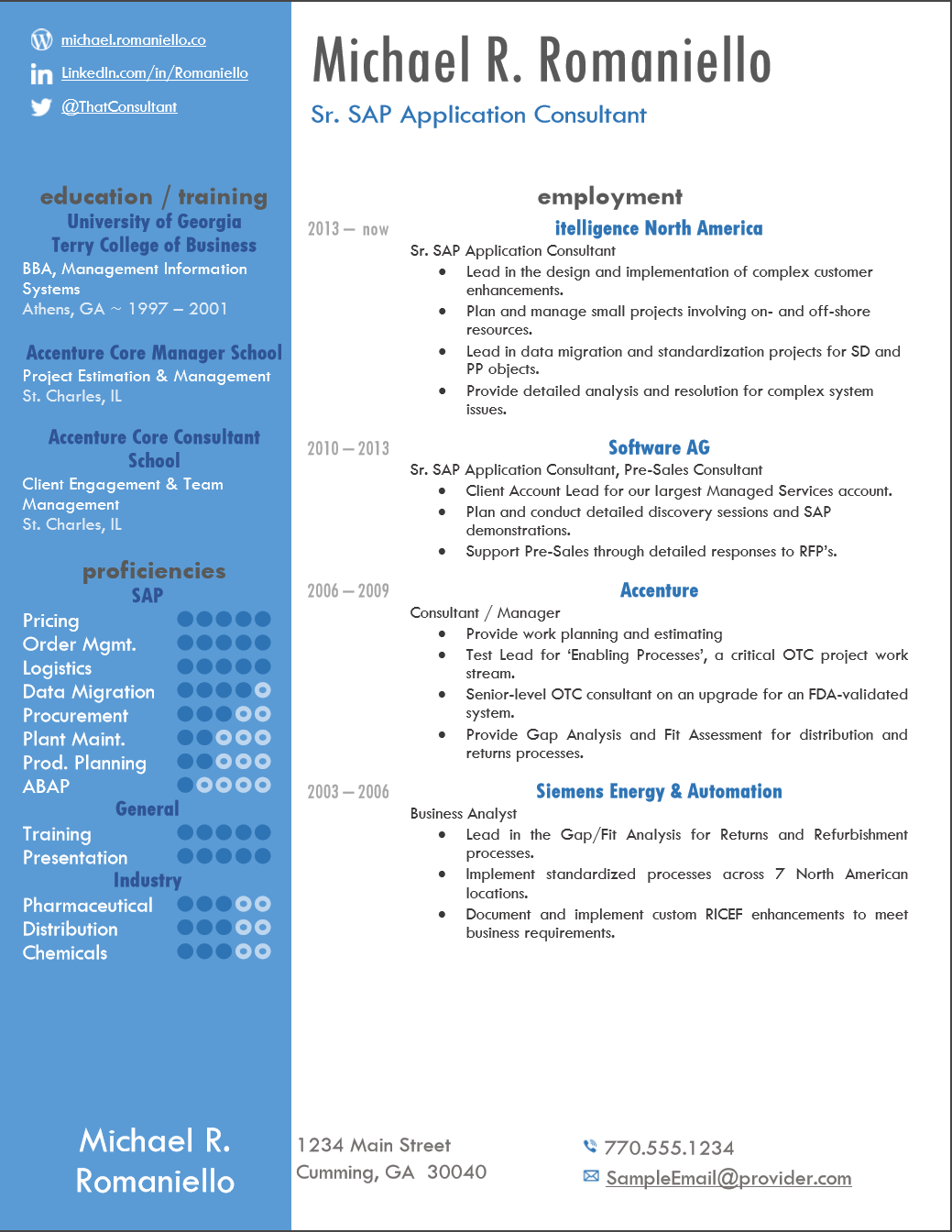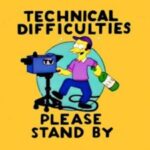Like many, I try to keep my Resume as fresh as possible. Even if you’re not actively job-hunting, updating your resume regularly will ensure that you’re capturing the more salient activities you’re performing and perhaps replacing those that are less important. But in the age of the cloud where LinkedIn reigns supreme, is it time to re-think the classic interpretation of the professional Resume? Is it time for a modern SAP resume?
What Is A Resume, Exactly?
Sounds like a crazy question, right? We’ve all been through enough Resume workshops to know that a resume is an endless list of every single task that we’ve ever done on every single project ever… Right? Unfortunately, some people seem to agree with this statement. I’ve had the pleasure of reading through about a half-dozen resumes lately while assisting with resourcing for a project. 15 pages of 10 point font is not a fun way to spend an afternoon.
To me, a resume should serve as a call to action. Just about my entire career history is catalogued on LinkedIn. Additionally, a detailed resume is available on my website (through the menu on the top of every page). Ideally, anyone interested in networking with me would visit one or both of those places. If I am distributing a resume, my goal would be to direct that person to those locations. That is my call to action.
Aren’t Paper Resumes Dead?
I’m not sure I understand the internet’s fixation with declaring things “dead”. First off, if you have to write an article in order to declare something dead, then it’s not dead. Dying maybe, but not dead. Despite this, there is still an ongoing debate online on whether or not paper resumes are dead. My opinion? With the rise of profiles on social networks and blogs — even “Video Resumes” — paper resumes are no longer the gold standard for introducing yourself to the world. However, you must keep in mind that at some point in time you are likely to sit down at a table with your prospective employers and peers and presenting a crisp resume could do nothing but help.
Types of Resumes
Ok, before we all go outside and roast S’mores over a resume-fueled bonfire, I want to be clear about this: There are different types and different uses for resumes:
- The “Master” Resume
Me: “My name is Michael, and I have a 5-page Resume.”
All: “Hello, Michael.”
It’s true. I totally have a 5-page resume and I call it my Master Resume. In it, I keep a catalogue of all the important tasks and projects that I have been involved with. Would I ever provide this to someone? No, not unless they have severe insomnia. Having a master resume allows me to pick-and-choose individual bullets for inclusion in a Tactical resume (more on that below). - The Social / LinkedIn Resume
I’m not sure if others would agree, but I feel that LinkedIn should reflect the same content as your Master Resume. People looking to connect will use LinkedIn to search based on keywords, so having a robust LI resume is important. - The Tactical Resume
Of course, you may find yourself going after a specific position. In this case, you probably need to craft a custom resume using a subset of items from your Master. These documents are frequently uploaded through some sort of job posting portal. - The Impromptu/Summary/Digital Resume
Everyone is familiar with the concept of an “elevator pitch” — a clear, concise summarized set of points that you can recite that you can give in about as much time as an elevator ride. These “pitches” are often intended to persuade the target. …a call to action, perhaps. This version of a resume should be your own personal elevator pitch in digital form — a .pdf file that can be circulated freely at a moment’s notice.
To be clear, it is this last type that I am considering while writing this article.
Stand Out With Your Resume
A recruiter once told me to “dispense with the boilerplate template” after reviewing my resume. I took a bit of offense to this as I had spent a lot of time crafting that format. I did as he suggested and ended up with a resume that probably looked like a majority of other resumes out there. I’m still not sure if I was helping HIM or helping myself. Of what benefit is a resume that resembles everyone else’s?
Instead, I think that the first step in achieving your call to action is to have a resume that stands out. It’s hard to get anyone to do anything if they don’t notice you first. Rather than add to the pile with another 3-page tome, why not provide something informational and concise, yet unique and memorable? But how can you do this?
- Be Open:
Not only are companies increasingly researching candidates through their social media accounts, but some employers actually require this as a part of the job application. Show them you have nothing to hide by providing links to relevant accounts. Assuming you have nothing to hide, that is. - Be Available:
Show that you are as accessible as your are desirable. Provide a variety of ways to connect: email address, physical address, phone, and LinkedIn should be the bare minimum. - Show Some Character:
If you do a Google image search for “Modern Resume”, you will see all sorts of examples of what’s possible. Charts and graphs on your resume? Why not! Infographics? People LOVE infographics! I just wouldn’t get too carried away; you’re trading in valuable space and you don’t want to give up substance for what could be considered gimmicky. Be sure to stay on *THIS* side of “professional”.
Example of Modern Resumes For An SAP Consultant
I decided to craft a few examples of what a “Modern Resume” may look like for an SAP Consultant (myself, obviously). As I recommended above, I did some searching online for some “modern resumes” and many great examples popped up. I used the following guiding principles when designing the samples:
- Single-Page
To me, it’s important to get this type of document down to one page. As mentioned before, I want to give the reader enough information to pique their interest and provide an outlet (or two) to learn more — namely, LinkedIn. - Concise
Just because I’m aiming for a single page doesn’t mean 10 pt, single-spaced font. I want to provide only the most important points which means ignoring everything else. - Easy to Read
I want to include a layout that is well-organized and informational. The addition of white space keeps the readers eyes focused on the content and not a sea of black and white text. - Interactive
I want links that can take the viewer from the PDF to locations to find out more about me. - Interesting
I used a color scheme and type face that is both easy to read and fun. Including logos and icons saves space and provides a little more context.
Both of the examples below contain the exact same content — just laid out differently:
Example SAP Resume 1:
This one is probably closer to a traditional resume with just a few modern elements to set it apart.

Example SAP Resume 2:
This version introduces a side bar which contains the more supplemental information while allowing the employment information to be featured in the main area to the right. The footer details remain the same.

Wrap-Up
I had fun taking a stab at modernizing my resume. [A bonus side-benefit is getting some more exposure to Word 2016.] As someone with over 15 years of post-university career experience, I’ll admit that I’m struggling with a Single-page summary. Like most of you, I’m proud of my career experiences and want to make sure it’s reflected on my resume. But I don’t want to lose sight of the fact that my career experience *IS* documented in two locations — both accessible from links on the PDF. If it becomes necessary to have everything “modernized”, I suppose you could create a separate “Project Summary” which goes into more detail about each project or role.
I’m sure that I’ll continue to tweak these designs as I come up with other ideas on how to better represent myself on the digital page. Please share any thoughts and reactions in the comments below.










Hi Michael,
I like the aesthetics of the resumes that you have here. However, when I consider some of the things that resume experts typically talk about (like keywords), I don’t see an effective way of adding those and enhancing the likelihood of one’s resume rising to the top out of a see of SAP resumes.
Do you have any pointers on that one issue?
Yoba, Sorry for the delayed response. You bring up a great point. I should note that I am not an expert in recruiting; I cannot pretend that I know the ins and outs of the tools used for finding and qualifying candidates. I’m sure there’s a lot to it, and I’m certain that text searches are really the only want to sort through a database of potential candidates. It seems that social networks like LinkedIn have replaced the traditional resume. A one-pager like I presented in my article is probably best served as an attention-getter and a mechanism to prompt the recipient to seed additional information on a site like LinkedIn. I’m eager to hear your thoughts as I wish I had more insight here.
Hi Michael! I really enjoied your post, particulary the two resumes samples. Are them from any website? Thanks in advance.
Thanks for the comment, Rodrigo. I developed those examples myself in MS Word. I think this concept could work as a more casual resume or as more of an overview. If you talk to a recruiter, they will probably still tell you that they want all the details so they can load it into their database to be text-searchable. Are you thinking of using something like this? How would you use it?